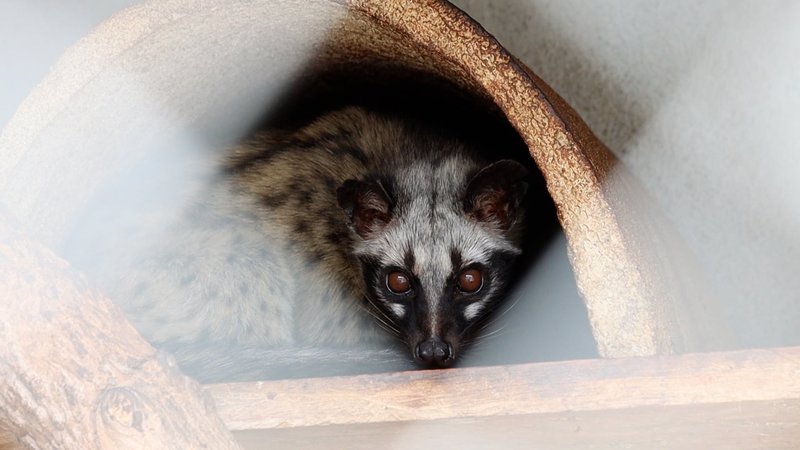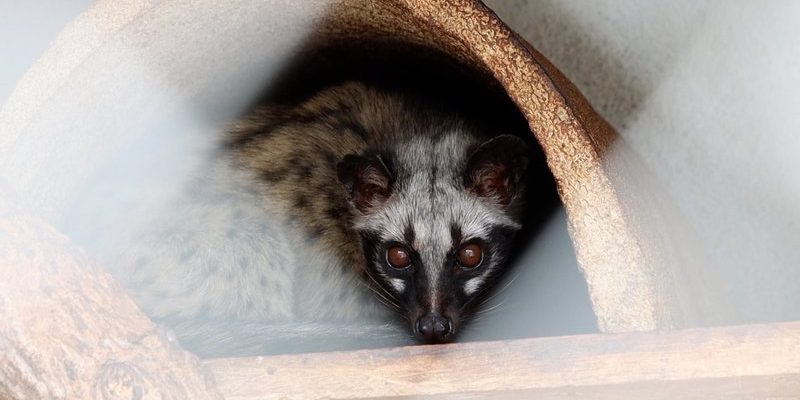
The Indian Civet is an intriguing creature often overshadowed by its more famous relatives, like cats or dogs. Imagine a small mammal with cat-like features, distinct markings, and an adaptable nature. These animals are a part of the civet family, which includes several species found throughout Asia and Africa. The Indian Civet, in particular, is native to the lush landscapes of India and some neighboring countries.
What makes the Indian Civet truly special is not just its charming appearance but also its fascinating habits. These nocturnal animals spend their nights exploring their environment, foraging for food, and avoiding predators. If you’ve ever wondered what it’s like to share your home with a creature that may look a bit like a mix between a cat and a raccoon, you’re in for a treat. Let’s dive deeper into understanding just what makes the Indian Civet such a remarkable animal.
Physical Characteristics
When you first lay eyes on an Indian Civet, you might notice its unique coat. Typically, they have a mix of gray and brown fur adorned with distinct black spots and stripes that give them a beautifully patterned appearance. Adult civets usually weigh between 5 to 10 kg (11 to 22 lbs) and measure around 60 to 90 cm (24 to 35 inches) in length, not including their bushy tails, which can be just as long as their bodies.
Another fascinating characteristic is their facial structure. The Indian Civet has a broad, flat face with a pointed snout. Its large, round eyes are perfectly suited for nighttime activity, providing excellent vision in low-light conditions. Their ears are relatively small but can pivot to pick up sounds from different directions. This unique blend of features helps them navigate the dark forests and grasslands they call home.
Habitat and Distribution
The Indian Civet predominantly resides in tropical and subtropical forests of India, but their range extends into parts of Nepal, Bhutan, and Bangladesh. These habitats provide the cover and food sources they need to thrive. Dense underbrush, tall grasses, and trees play a crucial role in their daily lives, offering both shelter from the elements and protection from potential predators.
Interestingly, these civets are remarkably adaptable. While they prefer forested areas, they can also thrive in agricultural landscapes or even urban settings. This adaptability allows them to explore a wider range of environments, although they typically retreat to denser vegetation during daylight hours to avoid danger. It’s like having a favorite cozy nook to curl up in after a long day of foraging!
Diet and Feeding Habits
As omnivores, Indian Civets have a varied diet that reflects their opportunistic feeding habits. They primarily feast on fruits, insects, small mammals, and even birds. Their keen sense of smell is key in locating food, allowing them to sniff out ripe fruits that may be hidden among the foliage. Imagine being able to pick the tastiest berries simply by following your nose!
During the night, they embark on their foraging adventures, often seen rummaging through the underbrush. This feeding behavior helps to control insect populations and disperse seeds, contributing positively to their ecosystems. They may even play a role in the growth of certain plant species, helping to maintain healthy forest dynamics.
Reproduction and Lifespan
The breeding season for the Indian Civet typically occurs during the warmer months. Mating can occur throughout the year, but it peaks when food sources are abundant. After a gestation period of about 60 days, females give birth to a litter of around two to four young, which are born blind and rely heavily on their mother for protection and nourishment.
Young civets grow rapidly, becoming independent around three months old. However, they may stay with their mother for up to a year, learning essential skills for survival. In the wild, Indian Civets can live up to 10 years, but their lifespan can be shorter due to predators and environmental factors. It’s like growing up in a big family, where you learn from your parents and siblings while exploring the world.
Behavior and Social Structure
Indian Civets are primarily solitary creatures, preferring to live alone or in small family groups. They are most active during the night, which is when they venture out to hunt and explore. This nocturnal lifestyle can be fascinating to observe, as they exhibit behaviors that are both curious and playful. When startled, they can make quick escapes, using their agility to dart into the underbrush.
Communication among civets often includes vocalizations like hisses, growls, and whines, which help them express themselves, especially during mating seasons. When they feel threatened, they can release a strong-smelling fluid from their anal glands, a defense mechanism that deters predators. It’s their way of saying, “Back off!” while adding a bit of humor to the situation.
Conservation Status
The conservation status of the Indian Civet varies across its range. While they are still relatively common in some areas, habitat loss due to farming and urbanization poses significant threats. Deforestation and land development can disrupt their natural habitats, making it harder for them to find food and shelter. Conservation efforts focus on preserving their habitats and promoting sustainable land-use practices to ensure their survival.
Additionally, awareness campaigns are crucial in educating local communities about the importance of the Indian Civet within the ecosystem. Protecting these animals not only secures their future but also maintains the ecological balance in their habitats. It’s like keeping a delicate tapestry intact, where each thread plays a vital role in the overall picture.
Interesting Facts about Indian Civets
| Size: | 60 to 90 cm (24 to 35 inches) long |
| Weight: | 5 to 10 kg (11 to 22 lbs) |
| Habitat: | Tropical and subtropical forests |
| Diet: | Fruits, insects, small mammals, and birds |
| Lifespan: | Up to 10 years in the wild |
| Activity: | Nocturnal |
In summary, the Indian Civet is a fascinating creature that plays an important role in its ecosystem. They navigate their world with agility and curiosity, embracing their nocturnal lifestyle. From their unique appearance to their varied diet, there’s so much to appreciate about these remarkable animals. Understanding and protecting the Indian Civet helps ensure that future generations will also have the chance to learn about this extraordinary species.
FAQ
What is the Indian Civet’s habitat like?
The Indian Civet mostly inhabits tropical and subtropical forests, thriving in environments rich in vegetation. They prefer areas with dense underbrush and tree cover, which offer protection and food sources. Additionally, they can adapt to agricultural lands and even urban settings, but they prefer natural habitats to fulfill their dietary and shelter needs.
How does the Indian Civet communicate?
Indian Civets communicate using a combination of vocalizations such as hisses, growls, and whines. These sounds help them convey their emotions, especially during mating or territorial disputes. Beyond vocalizations, they can also use their sense of smell to communicate with others, marking their territory with scent markings from their anal glands.
Are Indian Civets endangered?
While Indian Civets are not currently listed as endangered, they face threats from habitat loss, deforestation, and urbanization. Efforts to conserve their habitats and promote awareness about their ecological role are essential to ensure their populations remain stable in the wild.
What do Indian Civets eat?
The diet of an Indian Civet is quite varied, as they are omnivores. They typically eat fruits, insects, small mammals, and birds. Their opportunistic feeding habits allow them to adapt to the availability of food sources in their environment, foraging primarily at night when they are most active.
How long do Indian Civets live?
In the wild, Indian Civets can live up to 10 years. However, various factors such as predators, habitat loss, and food availability can impact their lifespan. In captivity, with proper care, they might live longer, benefiting from a controlled environment and regular access to food and veterinary care.
What is their role in the ecosystem?
Indian Civets play a crucial role in their ecosystems as both predators and seed dispersers. By preying on insects and small animals, they help control population sizes. Additionally, by eating fruits and then passing the seeds in their droppings, they contribute to plant growth and maintain ecological balance in their habitats.
Are Indian Civets social animals?
Typically, Indian Civets are solitary creatures. They prefer to live alone or in small family groups. While they may socialize during the breeding season, they generally lead independent lives, exploring their territories and foraging for food primarily by themselves.
Can Indian Civets be kept as pets?
Keeping Indian Civets as pets is not common and is often discouraged. They are wild animals with specific needs that are difficult to meet in a domestic setting. Additionally, they can be unpredictable and may have strong scent-marking behaviors, making them less than ideal companions for most households.
How do Indian Civets affect local agriculture?
Indian Civets can have both positive and negative impacts on local agriculture. On one hand, by preying on pests such as insects, they can help control crop damage. On the other hand, they may also raid fruit crops, causing potential issues for farmers. Understanding their behavior helps find a balance between conservation and agricultural practices.

